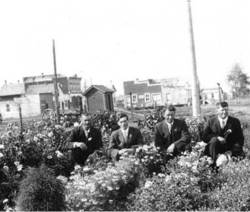Pipestone Flyer
The original settlers to the Millet area were made from tough stock. Some were pioneers that came west following the fur trade like Ben Slaughter, Millet’s first known settler, others were homesteaders who could weather the hardships of building a home in the wilds of the west. Phillip J. Mullins was a homesteader with a vision and branched out into real estate, dairy, and lumbering. He would sell land to new homesteaders and businesses to Millet and then supply them with lumber to build their homes and shops along with milk and cream for their homes.
The first settlers to the area were innovative, insightful, and ambitious with a bit of stubbornness. It would be their stubbornness that would cause the CPR to change their mind regarding the future of the Millet railroad station in 1917.
When the railroad first came through the area the conductor would help passengers and their baggage from the train. When the train then pulled out only Ben Slaughters fur warehouse could be seen. In 1902 a portable station was placed in Millet. It was no more than a boxcar with a peaked roof. Homesteaders that arrived during this time were left with their belongings on a 20 foot platform in what seemed to be the middle of nowhere with very few buildings to indicate any civilization.
By 1907 the community had grown and the railroad had enlarged the station to include a general waiting room, a ladies room, office, and a freight room. Upstairs were four bedrooms for the station agent’s family.
As the railroad became more and more popular for travellers wanting to go to either Calgary or Edmonton the railroad was under pressure to reduce the travel time down from the seven hours it took for the train to make all the stops. C.P.R. decided it could reduce the time to five hours if they could by-pass the stations that were not making money for the railroad. Millet made the list, not because it was losing money but it was only breaking even.
Cephas A. Kent, the railroad station agent was given notice that he would be transferred to Wetaskiwin and the Millet Station was about to become a flag stop. Word quickly spread and a board of trade was formed to protest C.P.R.’s decision. The railroad company refused to change their mind and began using a mail catcher to catch mailbags on the fly. More times than not the mailbag could be found just about anywhere except on the train. After watching this numerous times the citizens of Millet decided to take matters in their own hands.
One night about 30 minutes before the northbound train was due a large crowd of Millet residents and many surrounding homesteaders gathered with lanterns on the track a half-mile south of the station. As the train approached the engineer blew the train whistle, but nobody moved. The train stopped and after receiving a number of boos and jeers the conductor decided a stop at the station would be in order.
No one knows if the railway checked the books and realized that Millet should not have been on the list or if an executive had stepped in to reverse the decision but shortly after the protest the company informed the station agent his transfer had been rescinded and he was to remain as Millet’s station agent. Mr. Kent would remain as Millet’s agent for the next thirty years.
The station would continue to service Millet providing tickets, sending mail and receiving freight until the late 1950’s. It did become a flag stop for passengers until the 1970’s when passenger service was stopped and part of the station was demolished with the rest sold. Many of Millet’s original settlers, citizens and members of the armed services can trace their first or last impression of Millet as they passed through the station on their way to seek their future.
None of this would have been possible if the stubbornness of Millet residents, who refused to accept a bureaucrat decision, had not decided to block the train and changed the history of Millet!